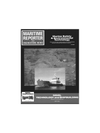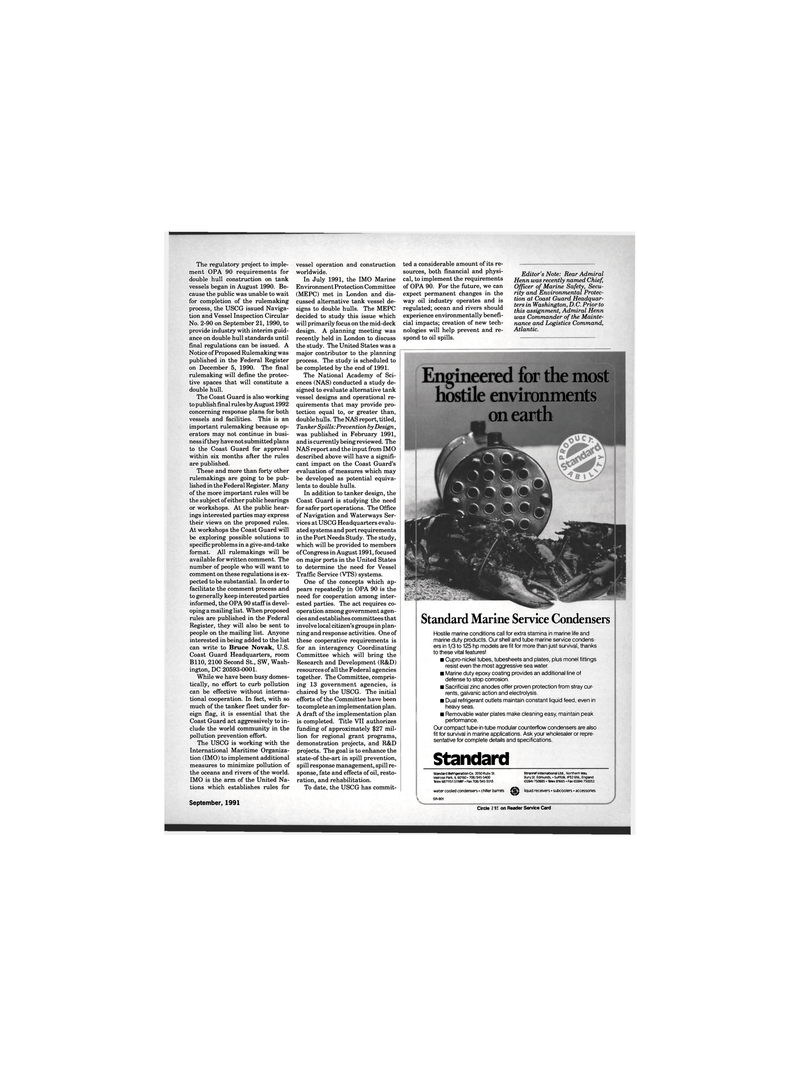
Page 4th Cover: of Maritime Reporter Magazine (September 1991)
Read this page in Pdf, Flash or Html5 edition of September 1991 Maritime Reporter Magazine
The regulatory project to imple- ment OPA 90 requirements for double hull construction on tank vessels began in August 1990. Be- cause the public was unable to wait for completion of the rulemaking process, the USCG issued Naviga- tion and Vessel Inspection Circular
No. 2-90 on September 21, 1990, to provide industry with interim guid- ance on double hull standards until final regulations can be issued. A
Notice of Proposed Rulemaking was published in the Federal Register on December 5, 1990. The final rulemaking will define the protec- tive spaces that will constitute a double hull.
The Coast Guard is also working to publish final rules by August 1992 concerning response plans for both vessels and facilities. This is an important rulemaking because op- erators may not continue in busi- ness if they have not submitted plans to the Coast Guard for approval within six months after the rules are published.
These and more than forty other rulemakings are going to be pub- lished in the Federal Register. Many of the more important rules will be the subject of either public hearings or workshops. At the public hear- ings interested parties may express their views on the proposed rules.
At workshops the Coast Guard will be exploring possible solutions to specific problems in a give-and-take format. All rulemakings will be available for written comment. The number of people who will want to comment on these regulations is ex- pected to be substantial. In order to facilitate the comment process and to generally keep interested parties informed, the OPA 90 staff is devel- oping a mailing list. When proposed rules are published in the Federal
Register, they will also be sent to people on the mailing list. Anyone interested in being added to the list can write to Bruce Novak, U.S.
Coast Guard Headquarters, room
B110, 2100 Second St., SW, Wash- ington, DC 20593-0001.
While we have been busy domes- tically, no effort to curb pollution can be effective without interna- tional cooperation. In fact, with so much of the tanker fleet under for- eign flag, it is essential that the
Coast Guard act aggressively to in- clude the world community in the pollution prevention effort.
The USCG is working with the
International Maritime Organiza- tion (IMO) to implement additional measures to minimize pollution of the oceans and rivers of the world.
IMO is the arm of the United Na- tions which establishes rules for
September, 1991 18 vessel operation and construction worldwide.
In July 1991, the IMO Marine
Environment Protection Committee (MEPC) met in London and dis- cussed alternative tank vessel de- signs to double hulls. The MEPC decided to study this issue which will primarily focus on the mid-deck design. A planning meeting was recently held in London to discuss the study. The United States was a major contributor to the planning process. The study is scheduled to be completed by the end of 1991.
The National Academy of Sci- ences (NAS) conducted a study de- signed to evaluate alternative tank vessel designs and operational re- quirements that may provide pro- tection equal to, or greater than, double hulls. The NAS report, titled,
Tanker Spills: Prevention by Design, was published in February 1991, and is currently being reviewed. The
NAS report and the input from IMO described above will have a signifi- cant impact on the Coast Guard's evaluation of measures which may be developed as potential equiva- lents to double hulls.
In addition to tanker design, the
Coast Guard is studying the need for safer port operations. The Office of Navigation and Waterways Ser- vices at USCG Headquarters evalu- ated systems and port requirements in the Port Needs Study. The study, which will be provided to members of Congress in August 1991, focused on major ports in the United States to determine the need for Vessel
Traffic Service (VTS) systems.
One of the concepts which ap- pears repeatedly in OPA 90 is the need for cooperation among inter- ested parties. The act requires co- operation among government agen- cies and establishes committees that involve local citizen's groups in plan- ning and response activities. One of these cooperative requirements is for an interagency Coordinating
Committee which will bring the
Research and Development (R&D) resources of all the Federal agencies together. The Committee, compris- ing 13 government agencies, is chaired by the USCG. The initial efforts of the Committee have been to complete an implementation plan.
A draft of the implementation plan is completed. Title VII authorizes funding of approximately $27 mil- lion for regional grant programs, demonstration projects, and R&D projects. The goal is to enhance the state-of the-art in spill prevention, spill response management, spill re- sponse, fate and effects of oil, resto- ration, and rehabilitation.
To date, the USCG has commit- ted a considerable amount of its re- sources, both financial and physi- cal, to implement the requirements of OPA 90. For the future, we can expect permanent changes in the way oil industry operates and is regulated; ocean and rivers should experience environmentally benefi- cial impacts; creation of new tech- nologies will help prevent and re- spond to oil spills.
Editor's Note: Rear Admiral
Henn was recently named Chief,
Officer of Marine Safety, Secu- rity and Environmental Protec- tion at Coast Guard Headquar- ters in Washington, D.C. Prior to this assignment, Admiral Henn was Commander of the Mainte- nance and Logistics Command,
Atlantic.
Engineered for the most hostile environments on earth
Standard Marine Service Condensers
Hostile marine conditions call for extra stamina in marine life and marine duty products. Our shell and tube marine service condens- ers in 1/3 to 125 hp models are fit for more than just survival, thanks to these vital features! • Cupro-nickel tubes, tubesheets and plates, plus monel fittings resist even the most aggressive sea water. • Marine duty epoxy coating provides an additional line of defense to stop corrosion. • Sacrificial zinc anodes offer proven protection from stray cur- rents, galvanic action and electrolysis. • Dual refrigerant outlets maintain constant liquid feed, even in heavy seas. • Removable water plates make cleaning easy, maintain peak performance.
Our compact tube-in-tube modular counterflow condensers are also fit for survival in marine applications. Ask your wholesaler or repre- sentative for complete details and specifications.
Standard
Standard Refrigeration Co. 2050 Ruby St.
Melrose Park. IL 60160 • 708/345-5400
Telex 6871151STNRF • Fax 708/345-3513 water cooled condensers • chiller barrels
V SR-901
Stranref International Ltd., Northern Way
Bury St. Edmunds. • Suffolk. IP32 6NL. England (0284) 750985 • Telex 81665 • Fax (0284) 750052 ^^ liquid receivers • subcoolers • accessories
Circle 317 on Reader Service Card

 3rd Cover
3rd Cover

